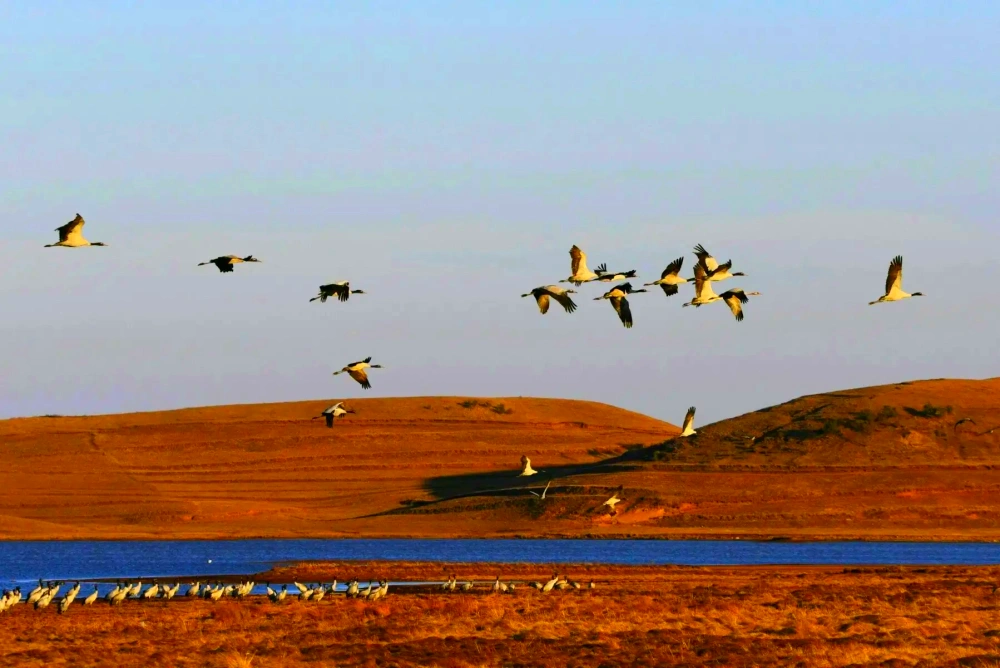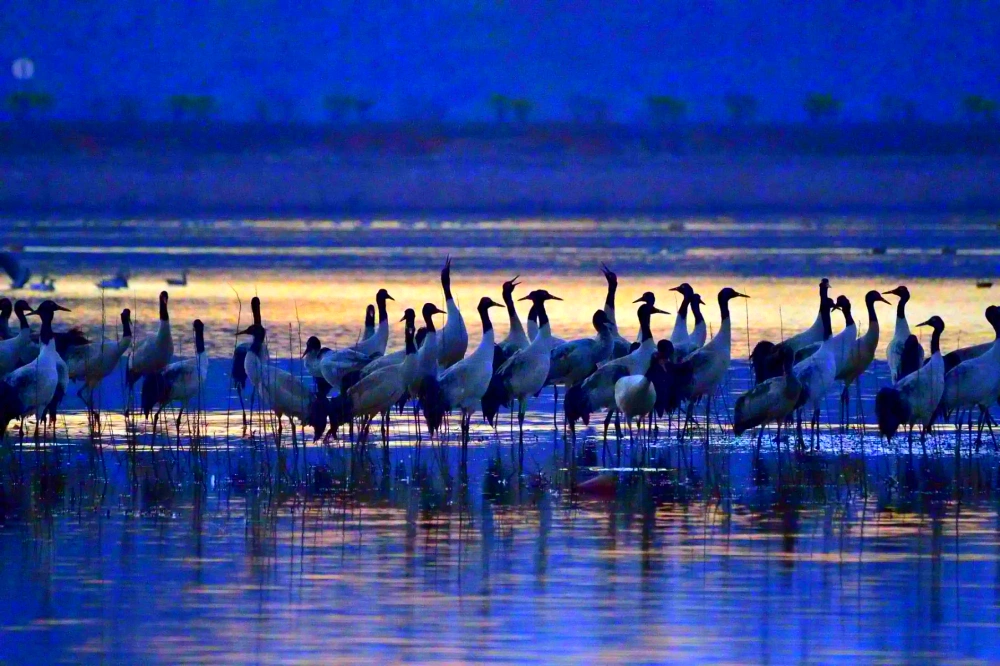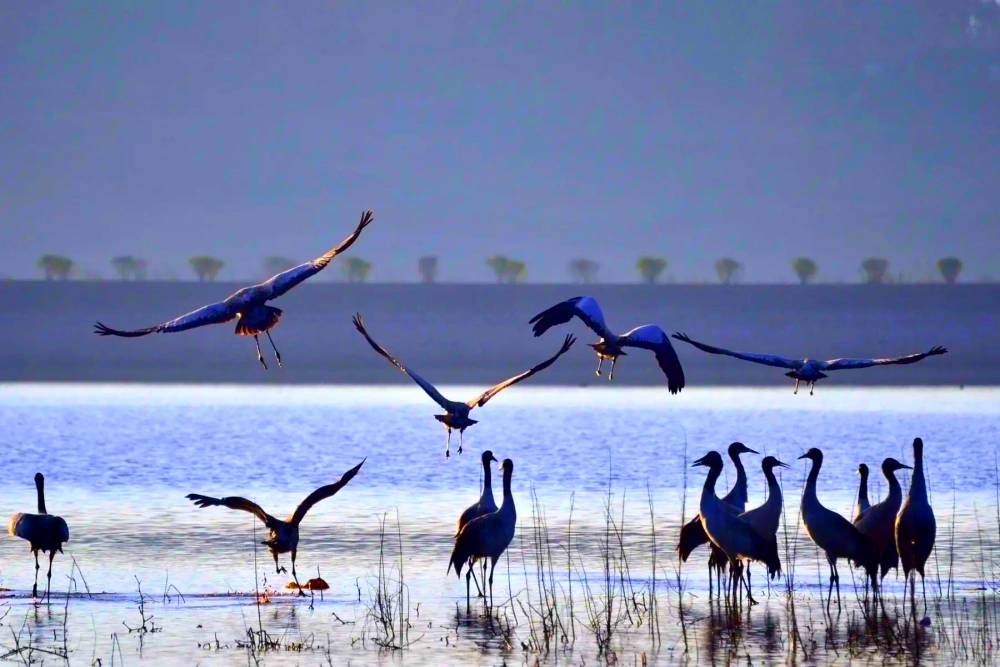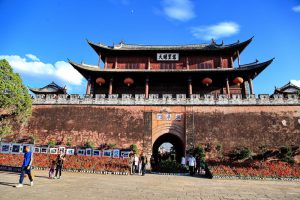
Daqiao Black-necked Crane National Nature Reserve and Nainhu Lake in Huize County, Qujing
Chinese Name: 曲靖市会泽大桥黑颈鹤国家级自然保护区
English Name: Daqiao Black-necked Crane National Nature Reserve in Huize County, Qujing
Area Coverage
The total area of the reserve is 12,910.64 hectares, with the Daqiao section covering 9,076.28 hectares and the Changhaizi section covering 3,834.36 hectares. The core area is 3,930.79 hectares, accounting for 30.45% of the total area; the buffer zone covers 4,313.20 hectares, accounting for 33.40%; and the experimental area covers 4,666.65 hectares, accounting for 36.15%.
Protected Objects
The Huize Black-necked Crane National Nature Reserve primarily protects the ecological environment of the Black-necked Crane and its wintering wetland habitats. Additionally, it protects other national first-class protected animals such as the Black Stork, Mandarin Duck, and 102 other bird species.
Plant Resources
- The reserve records a total of 482 species of wild vascular plants belonging to 118 families and 317 genera. This includes 48 species, 30 genera, and 17 families of ferns; 436 species, 287 genera, and 103 families of seed plants (including 12 species, 9 genera, and 4 families of gymnosperms; and 422 species, 278 genera, and 97 families of angiosperms).
- The vegetation types in the reserve include evergreen broad-leaved forests, deciduous broad-leaved forests, warm-temperate coniferous forests, temperate coniferous forests, sparse shrubs and grasslands, shrubs, meadows, aquatic vegetation, and dryland vegetation.
Animal Resources
The Huize Black-necked Crane Reserve has recorded 186 species of terrestrial vertebrates belonging to 4 classes, 23 orders, and 58 families. This includes 28 species of mammals, 131 species of birds, 13 species of reptiles, and 6 species of amphibians.
Among them, the Leopard Cat and Himalayan Striped Squirrel are listed as vulnerable and endangered species in the “China Red Data Book of Endangered Animals” (edited by Wang Song, 1998). Four species of birds including the Black-necked Crane, Black Stork, Mandarin Duck, and Golden Eagle are listed as national first-class protected animals. Seven species including the Intermediate Egret, Mandarin Duck, Black Kite, Eurasian Sparrowhawk, Eurasian Kestrel, Northern Goshawk, Peregrine Falcon, Red-tailed Hawk, White-bellied Pheasant, Common Crane, and Hooded Crane are listed as national second-class protected animals. Three species including the Bar-headed Goose, Ferruginous Duck, and Black-crowned Barwing are listed as Yunnan provincial key protected bird species. Among these protected bird species, the Black-necked Crane is listed in Appendix I of the Convention on International Trade in Endangered Species of Wild Fauna and Flora (CITES), while the Black Stork, Intermediate Egret, Hooded Crane, and Golden Eagle are listed in Appendix II of CITES. One species of amphibian, the Double-sporum Spiny Frog, is listed as vulnerable in the “China Red Data Book of Endangered Animals.” The reserve is also home to over 5,000 other waterfowl, including 17 species of diving birds such as grebes, cormorants, and terns, and 21 species of wading birds such as herons, egrets, cranes, and rails. Larger populations include the Common Teal and Northern Shoveler, each numbering nearly a thousand individuals.
(1) Black-necked Crane (Grus nigricollis)
The Black-necked Crane is a national first-class protected wild animal. The Huize Black-necked Crane Nature Reserve is one of the main wintering grounds for Chinese Black-necked Cranes, with over 500 individuals typically wintering here. Their wintering habitats mainly consist of marsh wetlands (over 60%), grasslands (20-38%), and agricultural fields and shallow water wetlands (less than 10%).
(2) Common Crane (Grus grus)
A national second-class protected wild animal. According to a 2002 survey organized by the Provincial Forestry Department, there were over 740 Common Cranes in the reserve, with 690 in Daqiao and over 40 in Changhaizi. However, a comprehensive scientific survey in February 2009 showed a decrease to just over 400 individuals.
(3) Scaly-sided Merganser (Mergus squamatus)
A national first-class protected wild animal, rarely seen. On January 13, 2004, a pair was found foraging in shallow water areas of Daqiao Reservoir amidst a mixed group including Common Mergansers. On February 4th and 5th, 2009, two individuals were observed at the head and tail of Daqiao Reservoir, respectively, mingling with Common Mergansers.
(4) Black Stork (Ciconia nigra)
A national first-class protected animal listed in CITES Appendix II, occasionally seen as a winter migratory bird. One was found in the Daqiao area in the winter of 2003, and two were found in Changhaiwei on December 13, 2008.
(5) Golden Eagle (Aquila chrysaetos) and other Raptors
The Golden Eagle is a national first-class protected animal, a rare resident bird. It is occasionally seen circling above wetlands, but in very small numbers. Other raptors such as the Black Kite, Eurasian Sparrowhawk, Eurasian Kestrel, Northern Goshawk, and Peregrine Falcon are frequently observed hovering over wetlands, waiting to hunt. A few species of owls are also reported locally, but their types have not been confirmed.
(6) Eurasian Spoonbill (Platalea leucorodia)
A national second-class protected animal, occasionally seen as a migratory or wintering bird. Two were found in winter 2008.
(7) Mandarin Duck (Aix galericulata)
A national second-class protected wild animal. Previously unrecorded in the reserve, one was found dead from predation by raptors on February 8, 2007, by Yang Hua, a villager of Daqiao Township.
(8) Bar-headed Goose (Anser indicus)
A Yunnan provincial protected wild animal. On February 5, 2009, over 500 Bar-headed Geese were found gathering at the water’s edge of Haizitou in Daqiao to roost overnight. According to scientific expedition reports, the Huize Black-necked Crane Nature Reserve is the largest wintering ground for Bar-headed Geese in the province, accounting for more than half of the total population.
(9) Ruddy Shelduck (Tadorna ferruginea)
A Yunnan provincial protected wild animal. According to a 2002 survey of major wetlands in the province, there were about 6,000 individuals, with over 2,300 in both Daqiao and Changhai, accounting for about 38% of the total. A station survey in 2004 found 3,880 individuals, and a scientific expedition in 2008 estimated around 2,500, averaging about 3,000 individuals, representing 50% of the total Ruddy Shelduck population in major wetlands of the province. During the scientific survey, the largest aggregation observed was 123 individuals. However, during a survey from February 3-8, 2009, the number had significantly decreased to just over 1,000 individuals.
(10) Swan Goose (Anser cygnoides)
Occasionally seen as a migratory bird and wintering bird. Previously unrecorded in Yunnan Province, two were captured by farmers in Jinzhong Town, Huize County in December 1999. On February 4, 2009, one was found in a flock of Bar-headed Geese at Daqiao.
The conservation measures undertaken since the Huize Black-necked Crane National Nature Reserve
Since becoming a national-level protected area, the reserve has implemented the following resource management and conservation efforts:
- Patrol and Monitoring: Employed local patrol personnel, combining professional staff with local community members. Seasonal patrols focus primarily on monitoring and guarding protected species within the reserve, with a primary focus on Black-necked Cranes and Common Cranes, as well as other large waterfowl wintering in the area.
- Supplementary Feeding: During heavy snowfalls or periods of food scarcity, caretakers provide supplementary feeding to Black-necked Cranes. This intervention ensures a food source for the cranes during difficult foraging periods, thereby safeguarding their wintering safety.
- Wetland Habitat Enhancement: Recognizing that marshlands are crucial to the survival of Black-necked Cranes, efforts were made to improve their habitat. From August 10 to August 18, 2008, a dam was constructed 100 meters long, located 1000 meters south of the reservoir tail in the Changhaizi area. This dam effectively increased the area of functional marsh wetlands by 2000 square meters, providing better nesting and foraging grounds for Black-necked Cranes.
- Grassland Restoration: Black-necked Cranes require open grassland (meadows) for their survival. To enhance their habitat and expand their foraging areas, a grassland restoration project was initiated around the water bodies of the Changhaizi area from August 1 to August 15, 2008. The project focused on restoring approximately 1000 mu (about 66.67 hectares) of grassland. The main grass species used included ryegrass, clover, and mountain fescue, chosen for their cold and drought resistance. The seeding was conducted using furrow and strip sowing methods, successfully restoring the grassland area.
These conservation efforts aim to protect and enhance the ecological environment of the Huize Black-necked Crane National Nature Reserve, ensuring the sustainable habitat for the Black-necked Cranes and other wildlife species within the reserve.

 7 Days GolfingTour
7 Days GolfingTour
 8 Days Group Tour
8 Days Group Tour
 8 Days Yunnan Tour
8 Days Yunnan Tour
 7 Days Shangri La Hiking
7 Days Shangri La Hiking
 11 Days Yunnan Tour
11 Days Yunnan Tour
 6 Days Yuanyang Terraces
6 Days Yuanyang Terraces
 11 Days Yunnan Tour
11 Days Yunnan Tour
 8 Days South Yunnan
8 Days South Yunnan
 7 Days Tea Tour
7 Days Tea Tour
 8 Days Muslim Tour
8 Days Muslim Tour
 12 Days Self-Driving
12 Days Self-Driving
 4 Days Haba Climbing
4 Days Haba Climbing
 Tiger Leaping Gorge
Tiger Leaping Gorge
 Stone Forest
Stone Forest
 Yunnan-Tibet
Yunnan-Tibet
 Hani Rice Terraces
Hani Rice Terraces
 Kunming
Kunming
 Lijiang
Lijiang
 Shangri-la
Shangri-la
 Dali
Dali
 XishuangBanna
XishuangBanna
 Honghe
Honghe
 Kunming
Kunming
 Lijiang
Lijiang
 Shangri-la
Shangri-la
 Yuanyang Rice Terraces
Yuanyang Rice Terraces
 Nujiang
Nujiang
 XishuangBanna
XishuangBanna
 Spring City Golf
Spring City Golf
 Snow Mountain Golf
Snow Mountain Golf
 Stone Mountain Golf
Stone Mountain Golf




















